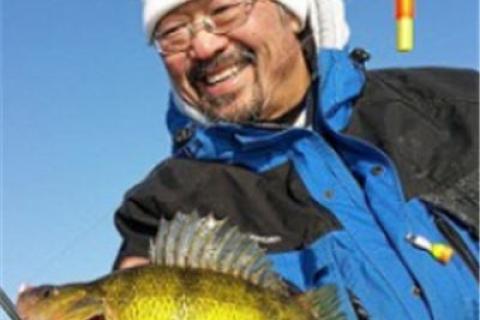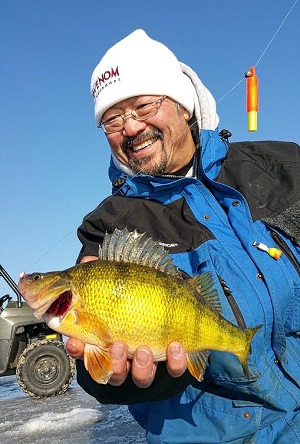
I've had many folks ask me how I got into fishing and how I learned the tricks to compete successfully at high-level, professional tournaments. Although my dad always took me and my brother fishing as youngsters, my true education came about as I got older. There are always many "educators" who play big parts in our lives. As it turns out, a little help is always needed from our friends.
This is where one of my very best friends, a gentle giant of a man and a tremendous angler comes in. My friend's name is Perry Parks, 54, from Papillion, Nebraska.
When I graduated from the University of Illinois in 1982, I hadn't really fished a whole lot. In fact, I wouldn't have even been able to identify a walleye as I only fished for crappies, bluegills, bullheads, and bass with my dad. And too much school work and socializing at college kept me busy and away from the sport that would eventually become my business.
 A college fraternity brother of mine (John Campbell) and I went on one of our first fishing adventures to Lake Okoboji, Iowa in 1982. When we got there, we bought our bait from a small bait store called White Oaks Bait Shop. That's where we met Perry, the fishing guide.
A college fraternity brother of mine (John Campbell) and I went on one of our first fishing adventures to Lake Okoboji, Iowa in 1982. When we got there, we bought our bait from a small bait store called White Oaks Bait Shop. That's where we met Perry, the fishing guide.
We would hire Perry to take us out fishing and catch a ton of fish, which included my first walleye. We'd then bring 'em back to the bait shop, take bunches of pictures, and clean 'em. After many years of fishing with Perry, we eventually became close friends and have kept in touch over the years.
Perry started his fishing education at the tender age of four years old with the help of his dad. His dad, Jon, purchased White Oaks Bait Shop in 1973. Perry was 14 and in eighth grade. White Oaks was situated in Arnolds Park, close to the shores of West Lake Okoboji. West Lake Okoboji is one of the largest natural lakes in the state of Iowa.
Perry started to guide clients immediately at the age of 14 and some of his most mem
orable clients have included, George Brett, Fran Tarkenton, Wally Hilgenberg, and the 60s pop sensation, "The Monkees"!
In those days, it was difficult keeping a brand new bait shop in business. In addition to bait and tackle, one of the key revenue generators was the cleaning of fish for their customers in addition to any other angler who didn't want to get their hands slimy. In those days, bullheads were 5 cents and small fish like perch and walleye were 10 cents apiece to clean. Try to guess who was recruited to clean all of the fish. If you guessed Perry, you were right. His brother Eric, who was 3 years younger, was also promoted to junior fish cleaner.
With the old records his dad used to write down, Perry has figured that they used to clean up to 30,000 fish per year. He was a guide and cleaned fish for over 15 years. Go ahead and do the math... that's a lot of fish!
His dad taught Perry and Eric how to clean fish with a hand operated invention called the Townsend fish skinner. Being hand operated, the Townsend was somewhat difficult to use and took some effort to clean all of those fish. But, it did an excellent job of removing the rib bones and taking the skin off with no waste of meat. Jon was the kind of man who was always re-inventing the wheel so he tried many different ways to motorize this fish skinning device. Jon ended up passing away in 2010 without being able to see his dream fulfilled.
Perry, Eric, and a couple of other colleagues finally got together a couple of years ago to come up with an invention called the Skinzit, a motorized fish skinner that Jon would be glad to put his seal of approval on. It's fast, easy to use, and wastes no meat.
One of Perry's favorite pastimes is to ice-fish and one of his targeted species of fish to catch through the ices yellow perch. Perch are abundant in many lakes throughout the upper Midwest and known for their tender, white meat which many anglers cherish. These fish can be difficult to catch at times though. That's when Perry pulls out a trick that he learned while guiding on Okoboji. This secret tactic is one he calls, "Greenbacking".
A key part of Greenbacking consists of a 1/8 oz, homemade, leadhead jig which hangs horizontally, will sit upright when lying on the bottom, and has a bit of green tinsel floss which is wrapped on a gold hook just behind the bare leadhead of the jig. He then tips the fishing jig with 5 or 6 maggots.
When marking fish but getting no bites, Perry will immediately switch and drop the Greenback jig down to the bottom. He then clips a small, 1-inch, round bobber to the line. The critical part of employing this technique is to have no slack in the line, but the Greenback jig has to be right tight to the bottom. The bobber will lay sideways when set up correctly. Then quickly quiver the rod so that the bobber twitches, then watch the bobber. The bobber rolls upwards when a perch bites. Lift the rod slowly every few minutes, then set it back down still again and begin quivering again. Keep watching your electronics for signs of fish. You will not even be able to see the jig on your electronics because it is so tight to the bottom.
This technique has often pulled fish when no other lure or tactic has been successful. I've used this "Greenbacking" tactic several times and have had great success with other species such as walleyes as well.
I've modified "Greenbacking" by using a super sensitive float called the Venom float instead of the round bobber. The Venom float is awesome because it can be adjusted without having to cut the foam, re-rigging, or adding split shot. This is extremely valuable when you are switching jig sizes. Check out the Venom floats at www.venomfloats.com.
Perry Parks is a friend who has been an advisor, educator, and a tremendous influence in my life. Those are the kind of friends everyone needs to have.
Pros4- 1Source for Ted Takasaki and Scott Richardson
- 3819 views

